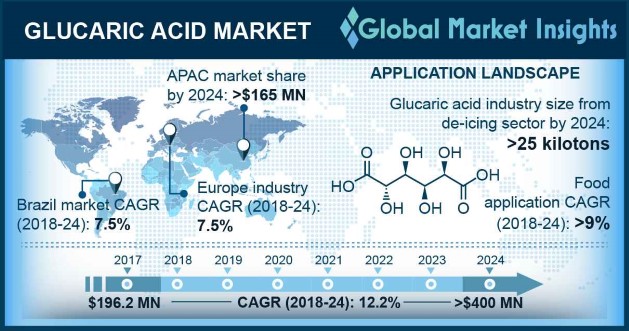Get a free sample of Glucaric Acid Market
Thank you!
Your inquiry has been received. Our team will reach out to you with the required details via email. To ensure that you don't miss their response, kindly remember to check your spam folder as well!
Form submitted successfully!
Error submitting form. Please try again.
Get a free sample of Glucaric Acid Market
Thank you!
Your inquiry has been received. Our team will reach out to you with the required details via email. To ensure that you don't miss their response, kindly remember to check your spam folder as well!
Form submitted successfully!
Error submitting form. Please try again.
Glucaric Acid Market Size
Glucaric Acid Market size was over USD 195 million in 2017 and industry expects consumption of above 140 kilo tons by 2024.

Increasing consumer inclination for bio-based products owing to their biodegradable and non-toxic nature along with enhancing product quality would propel glucaric acid market size. The product is also known and marketed by the name of saccharic acid. High demand for premium organic and multifunctional components has led to incorporation of advanced ingredient which may favour overall market growth. Growing environmental awareness is boosting sales for organic product, thereby driving saccharic acid industry growth.
Global detergent market is projected to exceed USD 205 billion by 2024, due to rising consumer disposable income and inclination to purchase quality products. The product is widely used in detergents owing to their production from renewable sources substituting phosphate from the process. Household segment is anticipated to lead industry over the forecast period. Rising penetration of automatic machines is expected to drive glucaric acid market growth over the predicted period.
Saccharic acid blocks the deposition of dirt and limescale on dishes and is utilized to substitute phosphate-based detergents which are currently being phased out owing to environmental concerns. The product can also be used in corrosion inhibitors and food ingredients which is likely to propel product demand in the forecast timeframe.
Increasing utilization of natural products in the manufacturing of food ingredients, detergents and corrosion inhibitors is expected to boost glucaric acid market demand. Changing purchasing patterns for chemical-free ingredients owing to their eco-friendly nature and technological advancements may drive saccharic acid demand in the estimated time period.
Global food ingredient industry size is likely to exceed USD 400 billion by 2022. Saccharic acid is often utilized as a component in nutraceutical supplements. Supplementing D-glucaric acid in human body through intake may eliminate harmful toxins, inhibit the growth of cancer cells, carcinogens, and ameliorate serum female hormone levels, thus propelling product demand.
Glucaric acid downstream potential includes potassium sodium glucaric acid, D-glucaric acid, and calcium D-glucarate which can be utilized as chelating agents. The product is unaffected to oxidation and reduction even at high temperatures. They are used as anti-plasticizer and additive that adds firmness & toughness to the resin and enhanced PVA fibres which finds application in production of biofriendly products including fibres, polymers, paints and diapers, which may drive saccharic acid industry growth.
Robust R&D supported with government initiatives for safe ingredients to encourage the utilization of organic and bio-based products has stimulated heavy investments on technology innovation. Acceptance of organic components to decrease contamination, increase in quality, meeting required specification along with stringent controlling standards by EPA, EU and FDA limiting utilization of synthetic constituents may favour glucaric acid industry growth.
Glucaric acid is manufactured from glucose, but technology has not yet been scaled up to industrial level. High cost of organic components may affect product price trends, thus hampering saccharic acid industry profitability. The catalysts required for its commercial production are costly and does not meet economies of scale if not produced in large quantities hence priced on a higher range.